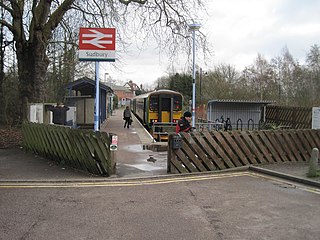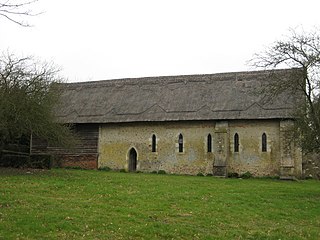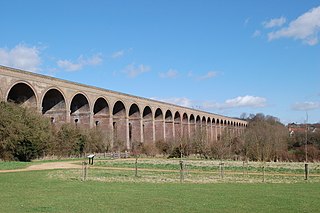
Sudbury is a market town and civil parish in the south west of Suffolk, England, on the River Stour near the Essex border, 60 miles (97 km) north-east of London. It is the largest town in the Babergh local government district and part of the South Suffolk constituency. In 2021 the built-up area had a population of 23,912 and the parish had a population of 13,619.

National Express East Anglia (NXEA) was a train operating company in England owned by National Express that operated the Greater Anglia franchise from April 2004 until February 2012. Originally trading as One, it was rebranded National Express East Anglia in February 2008. It provided local, suburban and express services from London Liverpool Street to destinations in Essex, Hertfordshire, Cambridgeshire, Suffolk and Norfolk in the East of England.

The Great Eastern Main Line is a 114.5-mile (184.3 km) major railway line on the British railway system which connects Liverpool Street station in central London with destinations in east London and the East of England, including Shenfield, Chelmsford, Colchester, Ipswich and Norwich. Its numerous branches also connect the main line to Southminster, Braintree, Sudbury, Harwich and a number of coastal towns including Southend-on-Sea, Clacton-on-Sea, Walton-on-the-Naze and Lowestoft.

The East Anglian Railway Museum is a museum located at Chappel and Wakes Colne railway station in Essex, England, which is situated on the former Great Eastern Railway branch line from Marks Tey to Sudbury. Services on the Sudbury Branch Line are operated by Abellio Greater Anglia.

Marks Tey is a large village and electoral ward in Essex, England; it is located six miles west of Colchester. It is one in a group of villages called The Teys, including Great Tey and Little Tey.

The Eastern Union Railway (EUR) was an English railway company, at first built from Colchester to Ipswich; it opened in 1846. It was proposed when the earlier Eastern Counties Railway failed to make its promised line from Colchester to Norwich. The businessman John Chevallier Cobbold and the engineer Peter Bruff were prominent in launching the company. The allied but nominally independent Ipswich and Bury Railway built a line onwards to Bury St Edmunds, also opening in 1846, and soon amalgamated with the EUR.

Marks Tey railway station is a stop on the Great Eastern Main Line (GEML) in the East of England, serving the large village of Marks Tey, Essex. It is 46 miles 49 chains (75.02 km) down the line from London Liverpool Street and, on the GEML, is situated between Kelvedon to the west and Colchester to the east. Marks Tey is also the southern terminus of the Gainsborough Line to Sudbury. The station is operated by Greater Anglia, which also operates all trains serving it, as part of the East Anglia franchise.

Sudbury railway station is the northern terminus of the Gainsborough Line, a branch off the Great Eastern Main Line in the East of England, serving the town of Sudbury, Suffolk. It is 11 miles 67 chains (19.05 km) down the line from the southern terminus of Marks Tey and 58 miles 32 chains (93.99 km) measured from London Liverpool Street; the preceding station on the branch is Bures. Its three-letter station code is SUY. The platform has an operational length for two-coach trains.

Bures St Mary is a civil parish in the Babergh district of the English county of Suffolk. In 2005 it had a population of 940, reducing to 918 at the 2011 Census. The parish covers the eastern part of the village of Bures, the western part being in the Bures Hamlet parish in Essex divided by the River Stour.

Bures railway station is on the Gainsborough Line, a branch off the Great Eastern Main Line to Sudbury, in the East of England, serving the village of Bures, which straddles the counties of Essex and Suffolk.

Chappel & Wakes Colne railway station is on the Gainsborough Line, a branch to Sudbury off the Great Eastern Main Line, in the East of England, serving the village of Wakes Colne and the neighbouring Chappel. It is 3 miles 49 chains (5.81 km) down the line from Marks Tey and 50 miles 18 chains (80.83 km) measured from London Liverpool Street. It is situated between Marks Tey and Bures. Its three-letter station code is CWC. Platform 1 has an operational length for five-coach trains. Platforms 2 and 3 are used by the East Anglian Railway Museum.

Shelford railway station is on the West Anglia Main Line serving the villages of Great Shelford, Little Shelford and Stapleford in Cambridgeshire, England. It is 52 miles 36 chains (84.4 km) down the line from London Liverpool Street and is situated between Whittlesford Parkway and Cambridge. Its three-letter station code is SED.

Hythe railway station in Essex is on the Sunshine Coast Line, a branch of the Great Eastern Main Line in the East of England, serving Hythe and other eastern areas of Colchester. It is 53 miles 49 chains (86.3 km) down the line from London Liverpool Street. Its three-letter station code is HYH.

Chappel is a village and civil parish in the City of Colchester district of Essex, England. The River Colne flows through the village. It is significant for its Victorian viaduct, which crosses the Colne valley.
The Colne Valley and Halstead Railway (CVHR) is a closed railway between Haverhill, Suffolk and Chappel and Wakes Colne, Essex, in England.
The Stour Valley Railway is a partially closed railway line that ran between Shelford, near Cambridge, and Marks Tey in Essex, England. The line opened in sections between 1849 and 1865. The route from Shelford to Sudbury closed on 6 March 1967 leaving only the section from Sudbury to Marks Tey, known as the Gainsborough Line, in operation.
The Long Melford–Bury St Edmunds branch line was a railway between Long Melford on the Stour Valley Railway and Bury St Edmunds on the Ipswich to Ely Line. The line opened on 9 August 1865 and closed to passengers on 10 April 1961 and freight on 19 April 1965.

Bentley railway station, also known as Bentley Junction between 1849 and 1878, was located in Bentley, Suffolk on the Great Eastern Main Line. It opened in 1846 and became a junction in 1847 when the Hadleigh Railway opened. The station was closed in 1966.

The Little Cornard derailment occurred on 17 August 2010 when a passenger train collided with a road vehicle on a level crossing on the Gainsborough Line near Little Cornard, Suffolk, and partly derailed. The vehicle, a tanker lorry, had begun crossing over the track when the Class 156 train from Sudbury destined for Marks Tey struck it whilst travelling at a speed of approximately 40 miles per hour (64 km/h).

The Chappel Viaduct is a railway viaduct that crosses the River Colne in the Colne Valley in Essex, England. It carries the Gainsborough Line which now is a short branch linking Marks Tey in Essex to Sudbury in Suffolk. The line previously, however, extended to Shelford in Cambridgeshire.



















